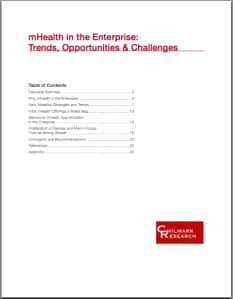 The rapid adoption of smartphones and now touch-screen tablets (e.g., iPad) by clinicians will trigger enormous growth in the use of mHealth Apps within healthcare enterprises, with the market for mHealth in the enterprise projected to reach $1.7B by end of year 2014. Similar to the hockey stick growth for mobile shown in the slide by Morgan Stanley’s Mary Meeker in last week’s post, the mHealth App market will see a similar trajectory as healthcare enterprises strive not only to meet physician demands for mobile access to clinical information, but seek to improve workforce efficiencies in preparation of future healthcare and payment reform.
The rapid adoption of smartphones and now touch-screen tablets (e.g., iPad) by clinicians will trigger enormous growth in the use of mHealth Apps within healthcare enterprises, with the market for mHealth in the enterprise projected to reach $1.7B by end of year 2014. Similar to the hockey stick growth for mobile shown in the slide by Morgan Stanley’s Mary Meeker in last week’s post, the mHealth App market will see a similar trajectory as healthcare enterprises strive not only to meet physician demands for mobile access to clinical information, but seek to improve workforce efficiencies in preparation of future healthcare and payment reform.
These findings and quite a bit more are part of Chilmark Research’s latest report that is being released today: mHealth in the Enterprise: Trends, Opportunities and Challenges. The report is the result of roughly three months of dedicated research by lead analyst Cora Sharma who has interviewed numerous leading adopters of mHealth Apps (Beth Israel Deaconess, Children’s Hospital Boston, UPMC and others) as well as both traditional HIT vendors, best-of-breed mHealth vendors and consultants.
While this report has plenty of charts and figures providing details as to what mHealth App categories will see the strongest growth in the healthcare enterprise and just how big those specific App markets will get, one area that will reach saturation in the very near future is medical content. Companies such as Epocrates, Medscape and Skyscape have been providing this capability for a number of years to physicians and we peg current adoption and use north of 60%. By the end of 2013, this market will reach saturation. This may partially explain Epocrates’ acquisition move yesterday, picking up Modality for $13.8M. Modality will provide Epocrates with critical relationships to many health content publishers and further solidify and strengthen its position in this market. But of Modality’s some 140 iOS-based Apps, only half are heath and life sciences related. Might Modality provide Epocrates the opportunity to expand into new markets now that the health content market is reaching saturation?
But we digress as health content Apps are strictly physician-driven – they do not connect into the enterprise’s health information systems (HIS) and are of limited value to a healthcare enterprise. What is of value to an enterprise is providing physicians with immediate access to the information they need to deliver the highest quality of care in the most efficient manner. This report specifically targets those enterprise mHealth Apps that link into a healthcare enterprise’s HIS including EHR, CPOE, eRx, CDS and Charge Capture. Providing physicians mHealth Apps that will enable them to deliver higher quality at the point of care will rapidly become an important competitive differentiator as healthcare enterprises look towards not only meeting meaningful use requirements and structuring themselves for payment reform, but also improve internal workflow leading to higher efficiencies and more competitive positioning in the broader market.
To obtain a copy of this report head over to the Chilmark Research Store.
ADDENDUM:
Have received a few private comments requesting Table of Contents, List of Figures, Table etc., which is now provided below:
Table of Contents
- Executive Summary
- Why mHealth in the Enterprise
- Early Adoption Strategies and Trends
- Initial mhealth Offerings a Mixed Bag
- Barriers to mHealth App Adoption in the Enterprise
- Proliferation of Devices and Macro Forces Promise Strong Growth
- Conclusion and Recommendations
- References
- Appendix
Figures
- Figure 1: Physician Adoption of mHealth Apps in the Enterprise, EOY 2010
- Figure 2: mHealth Apps Market Diffusion EOY 2010
- Figure 3: Physician Smartphone Adoption EOY 2010
- Figure 4: Physician Smartphone and Content App Adoption
- Figure 5: Worldwide Touchscreen Tablet Units Sales Forecast
- Figure 6: Physician Touchscreen Tablet Adoption Forecast
- Figure 7: mHealth Apps Market Size Forecast
- Figure 8: mHealth Apps Market Diffusion Forecast
Tables
- Table 1: Crucial Information Gathering Physician Usecases
- Table 2: Meaningful Use Stage 1 and mHealth Apps
- Table 3: Early Adopters of mHealth Apps
- Table 4: Usability Comparison by App Category Smartphones vs. Touchscreen Tablets
- Table 5: Architectural Deployment Tradeoffs: Benefits vs Costs
- Table 6: Representative Sample of Current Vendor Offerings
- Table 7: mHealth App Growth Forecast
- Table 8: Vendor Recommendations
- Table 9: Enterprise Recommendations





Interesting points about the saturation of content based healthcare apps. I think this is true. It’s likely also the reason that Epocrates is offering their own EHR software.
The only question I still have is if there really is an mHealth market in the enterprise or will that market really just be an extension of the existing enterprise application market. Maybe that’s splitting hairs, but the important point is that it will be a battle amongst existing vendors and less about new entrants to the market.
P.S. The link to your research is missing a :
Hi John,
Report does provide a representative sample of various mHealth solutions now available, several from the EHR vendors. As to whether or not there is a separate market, our research did determine that much of the mHealth market will eventually be dominated by the EHR vendors providing native mobile access to their apps such as what Epic has done with Haiku. But in more complex HIS environments with multiple systems, there are some unique opportunities for best-of-breed vendors and or some of the HIE vendors who are targeting the enterprise HIE market.
And thanks for the head’s up on the link, which is now fixed.
In the present generation mHealth is one the part of our life. It works as personal emergency resonance system. Now Vesag Introduced low cost remote health monitoring system.
VESAG is a comprehensive service to support senior citizens, kids, women and specially for Dementia patients.The VESAG health monitoring watch comes with an in-built GPS tracker, which makes it a critical companion when your loved ones are out of sight. It is a great guardian for kids, companion for women and buddy for visitors.
The VESAG watch essentially offers to monitor the key health parameters such as blood pressure, temperature, pulse, etc.; track the GPS location; as well as send alerts or make distress calls when the wearer is threatened.
Pardon my touch screen hobbled typing – getting a keyboard tonight. also my pc is dead so my usual resources aren’t available. Having said that:
Sounds like an important report.
Please clarify this”set to explode” vs my recollection that you’ve said there IS no mhealth market. I’m sure I overlooked something.
I hope to see you at Aligning Forces today.
Hi Dave and thanks for your comment, hobbled fingers and all. In answer to your question, in the previous post I was referring to those that see the market as something completely outside of what has been currently invested by healthcare enterprises in their existing HIS. At the mHealth Summit, there was much talk, much discussion about mHealth as being something outside all of this and my argument was, and still is, that mHealth will be an integral part of existing HIS, layered on top providing a more convenient means of access to information at the point of care. It is the Apps that enable this functionality where we see such tremendous growth.
Aligning Forces? Afraid I’m not aware of it, but then again, I’ve been hunkered down working on this report and the HIE report. No let up in sight.
The only question I still have is if there really is an mHealth market in the enterprise or will that market really just be an extension of the existing enterprise application market.
Initially, we see the enterprise mHealth market to simply be an extension of existing legacy applications that are reformatted for a touch-screen tablet or smartphone. But we also see a distinct opportunity for new applications (apps) that leverage the mobile platforms in the areas of CDS, patient education, and simulations, areas that EHRs and PACS are not well represented nor well-structured to support. There is also remote care & long-term care in the home where these devices and new apps that support such practices will shine.